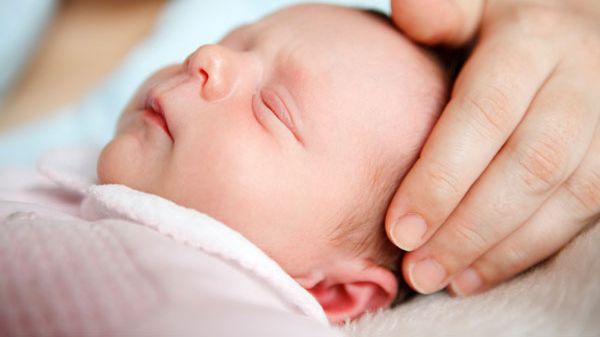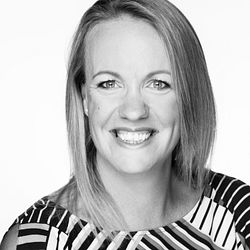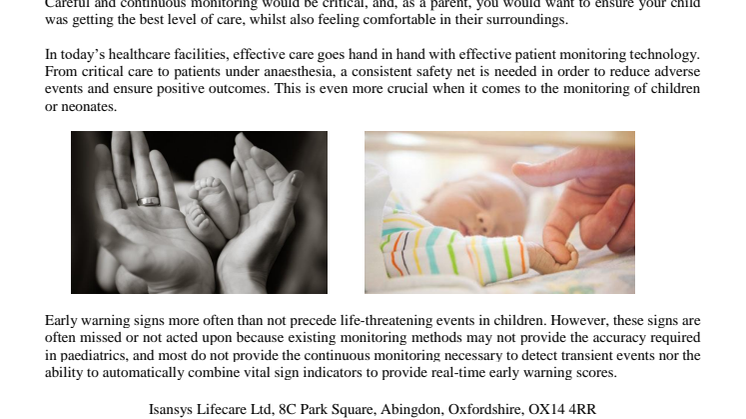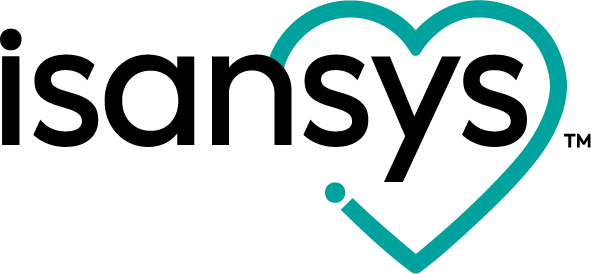
Blog post -
Remote Monitoring of Children – An Extra Level of Care
New parents often find themselves overwhelmed with the responsibility of taking care of a child.
Besides every day issues of care, there can also be concerns about the child’s health and well-being.
But, what if your child got sick or your baby was born prematurely?

Careful and continuous monitoring would be critical, and, as a parent, you would want to ensure your child was getting the best level of care, whilst also feeling comfortable in their surroundings.
In today’s healthcare facilities, effective care goes hand in hand with effective patient monitoring technology. From critical care to patients under anaesthesia, a consistent safety net is needed in order to reduce adverse events and ensure positive outcomes. This is even more crucial when it comes to the monitoring of children or neonates.


Early warning signs more often than not precede life-threatening events in children. However, these signs are often missed or not acted upon because existing monitoring methods may not provide the accuracy required in paediatrics, and most do not provide the continuous monitoring necessary to detect transient events nor the ability to automatically combine vital sign indicators to provide real-time early warning scores.
The National Patient Safety Agency, the National Institute for Health and Clinical Excellence and the Centre for Maternal and Child Enquiries have all recommended the implementation of early warning systems to identify clinical deterioration and initiate early treatment in children and neonates., A simple, low cost and clinically validated technology solution for this would mean a child’s observations could be performed more accurately and quickly, and they could return home sooner.



Current technologies available to monitor children generally involve wires, tubes and large, cumbersome machines. But, the good news is, this doesn’t have to be the norm.
Advances in wireless monitoring technology are enabling rapidly evolving and less invasive methods that have the potential to provide better care.
Isansys Lifecare Ltd in Abingdon, Oxfordshire, has developed a system that allows a child or neonate to be monitored continuously in real-time, ensuring deterioration is identified more quickly and timely treatment is given.
 The system, called the Patient Status Engine uses wireless sensors that attach to the body to monitor patients and free from the tyranny of leads, cables and wires. One of these sensors, the Lifetouch resembles a lightweight adhesive bandage strip. It is fitted, unobtrusively to the body and, regardless of whether the child is in bed, or in the playroom or being cuddled by with its parents, the Lifetouch collects data directly from the child and analyses the ECG of every heartbeat to provide continuous heart rate, respiration rate, heart rate variability and at the push of an on-screen button, a real-time ECG trace.
The system, called the Patient Status Engine uses wireless sensors that attach to the body to monitor patients and free from the tyranny of leads, cables and wires. One of these sensors, the Lifetouch resembles a lightweight adhesive bandage strip. It is fitted, unobtrusively to the body and, regardless of whether the child is in bed, or in the playroom or being cuddled by with its parents, the Lifetouch collects data directly from the child and analyses the ECG of every heartbeat to provide continuous heart rate, respiration rate, heart rate variability and at the push of an on-screen button, a real-time ECG trace.
The Lifetouch is one of the sensors comprising the Patient Status Engine (PSE. It is combined with the other wireless sensors to provide a multiple vital sign data capture and analysis system. The data from each sensor is transmitted via a low energy Bluetooth connection to the Isansys gateway located near to the bedside. The gateway analyses the data and wirelessly transmits the new clinical information into a central server and from there via web services delivers the patient status indicators to any authorised laptop, desktop or mobile device.
The PSE is currently being used in a pioneering research project at Birmingham Children’s Hospital which aims to save thousands of children and young people’s lives.
The project, called RAPID (Real-Time Adaptive & Predictive Indicator of Deterioration), is using biotelemetry and the wireless sensors designed by Isansys Lifecare to collect real-time data on vital signs such as heart rate, breathing rate and oxygen levels. This data is then analysed to predict when a child’s condition may be deteriorating, providing an early warning system that can be acted on immediately.
The project, the first of its type in the world, is jointly funded by a £1.8 million grant from the Wellcome Trust and the Department of Health, through the Health Innovation Challenge Fund, and is on plan to have recruited over 500 patients by April next year and 1,200 patients over the three year lifetime of the project.

This technology means that observations normally recorded every one to four hours on paper charts could potentially become a thing of the past with continuous individual monitoring that gives more accurate information helping to lead to faster treatment – saving lives and reducing hospital stays.
Health experts believe this technology is truly transformational. Dr Heather Duncan, Birmingham Children’s Hospital intensive care consultant and lead on the RAPID project, believes this technology will change the way we care for patients in hospital forever.
Monitoring children and neonates is a delicate task, but is one that is absolutely vital. With this technology now available, we’re enabling clinicians to monitor patients more closely and ensure a more accurate prediction of a patient’s deterioration. We’re also giving families the opportunity to get rid of cables and allow their child to have some freedom whilst being monitored continuously and receiving the best care possible.



